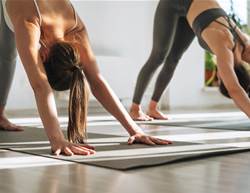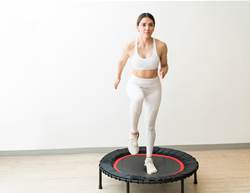Nordic walking isn’t just a creative way to increase your step count—it turns an everyday activity into a full-body workout. This fitness trend involves walking with long poles, much like ski or hiking poles, to help engage the upper body as you move.
“Poles can help push your body forward and carry you through space in a way that walking alone doesn’t,” says certified Nordic walking instructor Martica Heaner. Thanks to the poles, Nordic walking improves upper-body strength and stability while remaining low impact—making it an accessible but powerful alternative to jogging or running.
Here’s what Nordic walking involves, the benefits it offers, and what you’ll need to get started.
What is Nordic walking?
“Nordic walking is a type of physical activity where you walk using specially designed poles or sticks,” says certified personal trainer Eva Peña. It delivers a full-body workout that suits people of all ages and fitness levels.
While similar to skiing or hiking, Nordic walking doesn’t require mountains or trails. You can do it almost anywhere, and traditional walking shoes are perfectly fine. The poles help to drive your body forward, engaging the arms, shoulders and core, while offering all the lower-body benefits of walking.
Nordic walking benefits
Nordic walking offers a range of health benefits, making it a valuable addition to any fitness routine.
A full-body workout
Using poles creates a pushing and pulling motion that engages the triceps, lats, and core. Research has shown that Nordic walking improves upper-body strength, flexibility, and cardiovascular endurance in older adults. It adds more movement to your stride without increasing the impact on joints. The result is a more efficient and energising walk.
Supports heart health
Just like regular walking, Nordic walking boosts cardiovascular fitness. Studies on people with coronary artery disease found improvements in heart performance after regular Nordic walking sessions. Other research supports its benefits for mobility and upper-body strength. It’s a heart-smart way to stay active.
Burns more kilojoules
Because it involves more muscle groups, Nordic walking can help burn more energy than standard walking. Peña notes that it may burn up to 20% more kilojoules per session. That’s due to the added upper-body engagement from using the poles. It’s a simple swap that can support weight and energy goals.
Improves balance and stability
Nordic walking provides extra support, which is especially useful for people with joint pain or balance issues. The poles help you maintain an upright posture and even gait. Heaner adds that they offer a natural sense of balance while walking. This makes Nordic walking ideal for anyone needing a bit more support while staying active.
How to Nordic walk properly
Getting the most out of Nordic walking means using the right technique. Here’s how to do it:
- Keep your shoulders relaxed and your back straight to support good posture.
- Hold a pole in each hand, keeping them close to your body but angled behind you—this lets you use them to help push yourself forward.
- Walk with a natural stride, rolling your feet from heel to toe with every step.
- Your arms and poles should move opposite to your legs, creating a flowing, full-body rhythm.
Nordic walking sticks
Before heading out, make sure you have the right gear—particularly a pair of Nordic walking poles that suit your needs. Here’s what to look for:
- Height - Choose poles that are the right height for your body and the terrain. Properly sized poles help with balance and allow you to use your strength efficiently.
- Grip - Look for comfortable handles, preferably with straps that keep the poles secure even if you lose grip. This helps reduce strain and prevents accidents.
- Accessories - If you have arthritis or wrist issues, wearing gloves can ease pressure during longer walks. They provide extra comfort and help maintain a steady hold.
- Price - You don’t need to splurge, but it’s worth investing in gear that supports your activity. A quality pair of poles and comfortable walking shoes make a big difference.
Nordic walking vs. normal walking
Nordic walking offers a more dynamic alternative to regular walking. The key difference lies in the use of poles, which help engage more muscle groups. While standard walking provides plenty of benefits, Nordic walking adds an upper-body element that boosts its overall impact. Using specially designed poles activates the arms, shoulders and core, offering a more complete workout.









